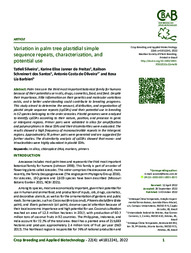Variation in palm tree plastidial simple sequence repeats, characterization, and potential use.
Variation in palm tree plastidial simple sequence repeats, characterization, and potential use.
Autoria: SILVEIRA, T.; FREITAS, K. E. J. de; SANTOS, R. S. dos; OLIVEIRA, A. C. de; BARBIERI, R. L.
Resumo: Palm trees are the third most important botanical family for humans because of their potential use in oils, drugs, cosmetics, food, and feed. Despite their importance, little information on their genetics and molecular variations exists, and a better understanding could contribute to breeding programs. This study aimed to determine the amount, distribution, and organization of plastid simple sequence repeats (cpSSRs) and their potential use in breeding in 52 species belonging to the order Arecales. Plastid genomes were analyzed to identify cpSSRs according to their nature, position, and presence in genic or intergenic regions. Primer pairs were validated in silico for amplification and polymorphisms in these SSRs and their dissimilarities were evaluated. The results showed a high frequency of mononucleotide repeats in the intergenic regions. Approximately 76 primer pairs were generated and are suggested for further studies. The dissimilarity analysis of cpSSRs showed that mono- and trinucleotides were highly abundant in plastid SSRs.
Ano de publicação: 2022
Tipo de publicação: Artigo de periódico
Unidade: Embrapa Clima Temperado
Palavras-chave: Palmeira
Observações
1 - Por padrão são exibidas publicações dos últimos 20 anos. Para encontrar publicações mais antigas, configure o filtro ano de publicação, colocando o ano a partir do qual você deseja encontrar publicações. O filtro está na coluna da esquerda na busca acima.
2 - Para ler algumas publicações da Embrapa (apenas as que estão em formato ePub), é necessário ter, no celular ou computador, um desses softwares gratuitos. Sistemas Android: Google Play Livros; IOS: iBooks; Windows e Linux: software Calibre.
Acesse outras publicações
Acesse a Base de Dados da Pesquisa Agropecuária (BDPA) para consultar o acervo completo das bibliotecas da Embrapa.

